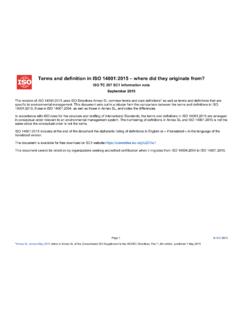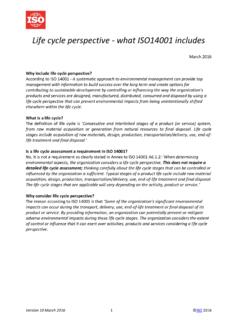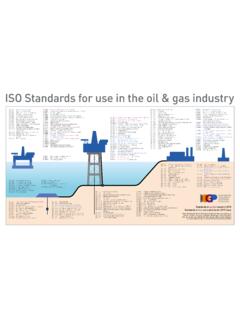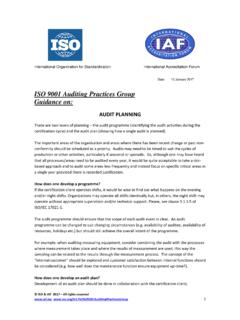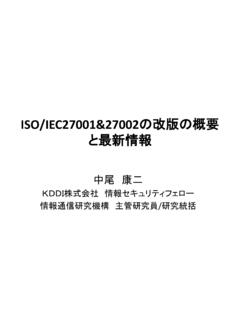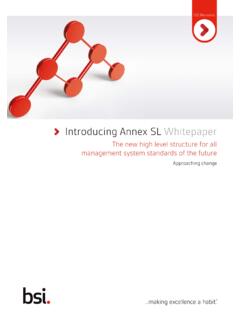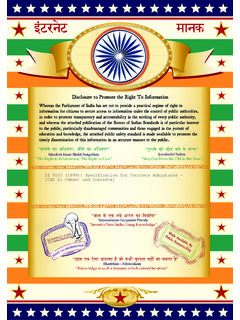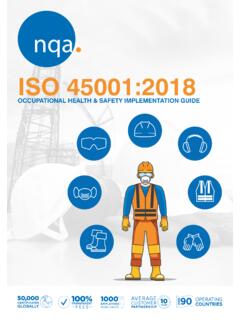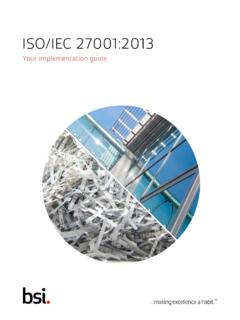Transcription of ISO 9001 Auditing Practices Group Guidance on: Scope and ...
1 ISO & IAF 2020 All rights reserved ; Version 2 2020-02-26 1 of 10 International Organization for International Standardization Accreditation Forum Web: Web : Edition 2 Date: 2020-02-26 ISO 9001 Auditing Practices Group Guidance on: Scope and applicability Contents Introduction .. 2 Difference between scopes .. 2 Auditor Guidance on QMS Scope .. 2 Organizational boundaries .. 3 Certification Scope .. 4 Scopes of certificate smaller than scopes of QMS .. 5 Audit Scope .. 6 Influence of outsourced processes on QMS, Certification and Audit Scopes .. 6 Applicability and non-applicability of ISO 9001 requirements .. 8 Applicability of design and development, Scope of the QMS and certificate .. 9 Scope and changes .. 10 ISO & IAF 2020 All rights reserved ; Version 2 2020-02-26 2 of 10 Introduction Scope of ISO 9001, Scope of Quality Management System (QMS), Scope of Certification and audit Scope refer to different things, yet, they are closely linked.
2 Auditors should be aware of the difference and interrelation between them, implications in the evaluation of QMS and certification Scope and potential impacts in the audit process. Within the Scope of the QMS, auditors should carefully analyse non-applicability of requirements. This paper is a major revision of the earlier paper Scope of ISO 9001, Scope of Quality Management System and Scope of Certification and replaces it. Difference between scopes ISO 9001 Scope - Clause 1 of ISO 9001 describes its Scope , the subject of the standard, quality management system, and the intended results of its application by organizations. QMS Scope - ISO 9001 Clause states that The organization shall determine the boundaries and applicability of the QMS to establish its The Scope shall state the types of products and services covered . Certification Scope - The Scope of certification is derived from the Scope of the QMS and is dependent on what the organization decides to have certified.
3 This Scope is used to communicate the certification status of the organization s QMS to relevant interested parties. Sometimes the Scope of certification can be smaller than the Scope of the QMS and special attention needs to be given to these cases. Audit Scope extent and boundaries of an audit (ISO 19011:2018, ). Note 1 to entry: The audit Scope generally includes a description of the physical and virtual locations, functions, organizational units, activities and processes, as well as the time period covered. As integrated management system audits become more prevalent, a brief note on Scope differences among them is appropriate. When more than one management system is being audited it is important that the audit objectives, Scope and criteria are consistent with the relevant audit programmes for each discipline and their respective scopes. Some disciplines can have a Scope that reflects the whole organization and others can have a Scope that reflects a subset of the whole organization [ISO 19011:2018 Clause ].
4 Auditor Guidance on QMS Scope The Scope is about determining applicability and limits of the QMS In order to establish applicability, the auditor should verify what products and services are managed within the formal QMS. The next step is to verify the processes needed to deliver the products and services, either performed or under the responsibility of the organization. Boundaries define the limits of the QMS. To increase understanding of the boundaries the auditor should get an insight into organizational structure and resources related to sites, physical and virtual, and infrastructure. Boundaries may be self-evident. For many organizations the QMS applies to all its products and services, includes all the processes performed at defined locations with established resources including people and the whole of the organization. ISO & IAF 2020 All rights reserved ; Version 2 2020-02-26 3 of 10 Both applicability and boundaries of the QMS are relevant but the first is particularly relevant to determine the Scope of the certificate and boundaries are critical to determine the audit Scope .
5 The Scope of the QMS can become more challenging to determine in circumstances where there is extensive or critical: number of products and services externally provided products, processes and services ( outsourcing); logistics; multiple sites; service centres; servicing at customer premises; collaborative products and services; shared facilities; projects limited by time, etc. These situations need to be carefully assessed to determine if the Scope was defined correctly by the organization and stated in a clear and non-misleading manner. The auditor should determine if any of these factors are present and if they affect the audit Scope . Organizational boundaries One of the more common boundaries auditors need to evaluate are the organizational boundaries determined by the organization. ISO 9000: 2015 defines an organization as a person or Group of people that has its own functions with responsibilities, authorities and relationships to achieve its objectives Note 1 to entry: The concept of organization includes, but is not limited to, sole-trader, company, corporation, firm, enterprise, authority, partnership, association, charity or institution, or part or combination thereof, whether incorporated or not, public or private.
6 Note 2 to entry: This constitutes one of the common terms and core definitions for ISO management system standards given in annex SL of the Consolidated ISO Supplement to the ISO/IEC Directives, Part 1. The original definition has been modified by modifying Note 1 to entry. If the organization is part of a larger entity, the auditor should check if organizational boundaries are well determined in the system. The auditor should also assess the implications to the audit Scope of processes that are outside the Scope of the QMS, but within the Scope of the larger entity. These may have an impact on the QMS. The auditor should evaluate how these processes are handled within the audit Scope . The same exercise applies when the organization is a combination of two or more different entities. To determine the Scope of the QMS the organization shall consider external and internal issues raised when establishing the context of the organization.
7 It is a clear expectation that these boundaries are identified as a relevant issue by the organization. ISO & IAF 2020 All rights reserved ; Version 2 2020-02-26 4 of 10 Certification Scope As certification plays an important role in contractual and regulatory fields, it is very important to establish the Scope of the certificate in a reliable and non-misleading manner. The terms Scope of the QMS and certification Scope are often used interchangeably due to the fact that in many situations they are equivalent. This can lead to confusion when an organization has chosen to limit its QMS Scope to only certain processes, products or services. A customer or end user must be able to discern the Scope of the ISO 9001 certification. Certification Scope is a term used to refer to the Scope in the certification document. This is usually a statement that describes the type of activities, products and services as applicable at each physical site without being misleading or ambiguous (ISO 17021:2015).
8 In the certification document the certified organization s name and physical location (or of the headquarters, and other physical sites, if applicable) are also stated. In order to avoid confusion and to enable identification of what has been certified, the Scope of certification should define, as appropriate: types of products and services provided; the organization's main operational processes for its products and services, such as design, manufacture, packaging, delivery, provision, etc. (to provide understanding of the position in the value chain and the main activity), related sites where these activities are performed and specific scopes, if relevant; Certification Scope begins to be evaluated by the certification body during the application process, is reviewed throughout the certification process, and regularly at surveillance and recertification activities.
9 The audit team has the task to assess and validate that the Scope statement proposed by the organization reflects truthfully what the organization provides and what is covered by the QMS. Auditors should not validate misleading Scope statements, such as: Scope text includes a reference to a normative document that might give the idea they are also certified to this standard. As ISO 9001 is a management system standard, a reference in the Scope statement to product or service specifications standards can give the idea that a claim for a certified product or service is included, which would be misleading. For example, Manufacturing of products in accordance with STD XXXX:YYYY . Scope is too broad or vague and gives incorrect impression of what the organization does: general construction vs. construction of roads only in the case that the organization only builds roads; construction vs.
10 Construction of buildings in the case that an organization only has capability/authorization to do buildings. Lists of portfolio products for which the organization cannot demonstrate provision; states a list of 10 products and only demonstrates to produce 3. Scopes with claims that cannot be substantiated, : Same day home repairs and audit evidence demonstrates that organization infrastructure is not adequate to ensure it. Scope which includes marketing or promotion statements: the cheapest and best product. ISO & IAF 2020 All rights reserved ; Version 2 2020-02-26 5 of 10 Scope that includes activities, products or services that the organization cannot demonstrate its capability to provide The auditor should also be aware that the Scope statement can be written in a language related to its business area, that, by their nature define the activities included.
